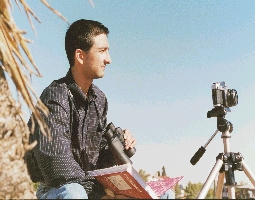Alaska's Northern Lights with Chris Grohusko
by Chris Grohusko with SpaceHike.com
More articles in PeopleWhat does it take to be not only a photographer, but a photographer who captures Alaska's Northern Lights in the desert from El Paso, Texas? If you are Chris Grohusko, you are dedicated to loving your work, and in being at the right spot at the right time. His work has been featured in Astronomy Magazine, El Paso Times, National Geographic Magazine, Space Illustrated Magazine, and Star Date Magazine, just to name a few. His list of credits continue to grow as shown in the following article:

Chris L. Grohusko and Glowing Visitor in the Desert
In their entire lifetime, most people in El Paso Texas never see a rare hidden secret of the desert's night time sky: Alaska's Northern Lights. But they were very luckily photographed on August 12, 2000 just on the outskirts of El Paso's suburbs by a devoted local expert stargazer/professional photographer, 25 year-old Chris Grohusko. On August 11, 2000, Chris had slept during the day until 4pm so he could photograph something entirely different (an annual meteor shower), but after arriving at his location about 10pm, something else began to catch his attention around 345 am August 12, 2000.
Very tall, slender, and perfectly focused beams of light like those used at a "Hollywood Movie Premiere" began to point up the sky from the northeastern mountains at Hueco Tanks Historical State Park, 32 miles East of El Paso or about a 45 minute drive from the suburbs of El Paso. Then, as Chris looked directly north about 15 minutes later, a tremendously thick and intensely tall curtain of light was hanging in the sky. It was made of 3 ripples or 3 thick rays of light which were very actively pulsing just like a person smoothly fooling with the dimming and brightness switch of the chandelier in your dining room. This curtain of light lasted for approximately 20 minutes during which time a golden shooting star (from the annual meteor shower) crashed directly through the curtain with the speed of a diving rocket. It all made for a spectacular hour from the "exotic and graceful territory of angels", as Chris mentions.
.jpg)
The requirement for these softly radiating, pulsing, and breathtaking curtains of light is the following: every 11 years the Sun arrives at the peak of its Sunspot Cycle, which during Fall and Spring throughout all of history, produces explosions on the Sun which bullet to our Earth a speeding and monstrous energy cloud containing a tiny piece of the atmosphere of the Sun, which charges the air we breathe to produce natural color. The Northern Lights are a naturally occurring phenomenon involving an electrical current of the Earth known as the electrojet, located hundreds of miles high in the sky's atmosphere. Once this powerful solar cloud arrives at the Earth, usually 24 to 48 hours after exploding from the Sun's surface, it then tremendously "surges" the Earth's main electrical current so the current becomes pushed away South from its normal location in Alaska to a rare location such as Texas. The lights then become visible in many forms out of the city limits, in this case only a 45 minute drive East of the suburbs of El Paso Texas. Chris's photograph has since been published in numerous local, state, national, and international magazines, newspapers, and websites because of this "once-in-a-lifetime" elegant photo opportunity. They include "Texas Highways" (March 2000), Astronomy (Dec 2000), a college textbook (by Jay Pasachoff), and Popular Photography Magazine (April 2002). "Chasing the sky with binoculars, telescopes, and cameras in the "back country" of El Paso for 3 years has finally launched me into the fast lane of the publishing industry", Chris says.
Chris welcomes all feedback and may be contacted:
by email: Chris Grohusko
by mail:
10328 Blackwood Ave., El Paso, Texas 79925
by phone:
915-593-0036